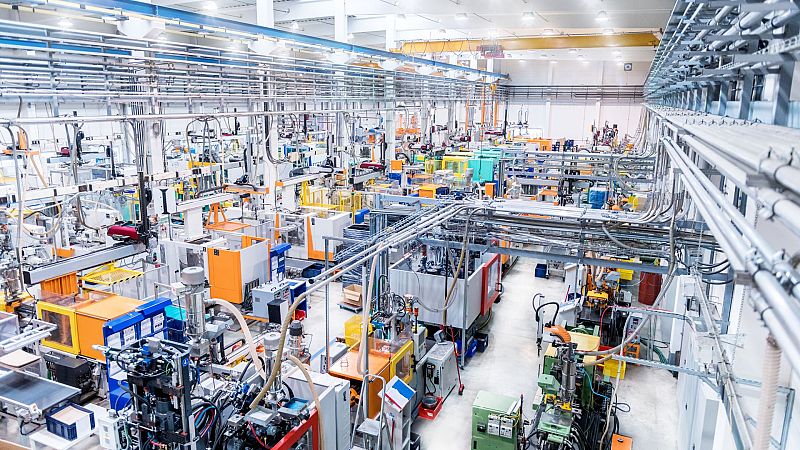
The HCOB Eurozone Manufacturing PMI for May 2025 was 49.4, up from 49.0 in April, according to S&P Global. However, this is still in contraction territory, as it was below 50, and marked the slowest pace of contraction in the manufacturing sector since August 2022.
Meanwhile, output rose for the third month in a row, with new orders stabilising after almost three years of decline. The rate of backlog depletion also dropped to the slowest pace since June 2022.
On the other hand, employment levels continued to lag, although they decreased at the slowest rate since September 2023.
Input costs fell for the second consecutive month, which was the fastest decline in 14 months, while output prices slid for the first time since February this year.
Business confidence improves in eurozone
Business confidence rose to the highest level in more than three years in May.
Dr. Cyrus de la Rubia, chief economist at Hamburg Commercial Bank, said in the May Eurozone PMI report: “The upward trend in the headline PMI is still continuing, pointing towards a recovery that is progressing. That is backed up by the rise in production we have seen since March.
“What is especially encouraging is that production has picked up across all four major eurozone economies, which really highlights how broad-based this recovery is. With output rising for three months in a row, historical patterns suggest there is a 72% chance we will see another increase in the next month.”
However, he highlighted that the possibility of the US imposing steeper tariffs against the EU is a major risk to this outlook.
“Still, companies are noticeably more upbeat than they were last month about producing more a year from now, which shows a certain resilience, even in the face of potential protectionist moves from across the Atlantic,” de la Rubia added.
Falling oil and gas prices and lower interest rates supported the eurozone manufacturing sector in May, with production rising in France, Germany, Spain and Italy.
Spain manufacturing sector outperforms market expectations
The HCOB Spain manufacturing PMI for May was 50.5, a jump from April’s 48.1, according to S&P Global. This was ahead of analyst expectations of 48.4. After three straight months of contraction, this was the first expansion in the Spanish manufacturing sector, while also being the highest number since January.
May’s higher figure could be because of underlying demand improving slightly. While uncertainties affected the sector significantly in April, the market seemed to readjust a little in May.
Spanish manufacturing sales volumes fell in May, however, the decline was the smallest in four months. Companies continued to hire for the third consecutive month, while input costs fell for the first time since the beginning of last year.
Output prices also dropped at the fastest rate since September 2024, mainly due to higher market competition. Similarly, output sentiment for the next 12 months rose to a three-month high.
Jonas Feldhusen, junior economist at Hamburg Commercial Bank, said in the May Spain PMI report: “Spain’s manufacturing sector sent encouraging signals in May. Whether this improvement is partly attributable to early signs of easing in the global tariff conflict remains uncertain.
“While Spain’s direct dependence on the U.S. market is relatively limited compared to countries like Germany or Italy, indirect effects from a generally improved global trade outlook may also be contributing.”
Germany’s manufacturing sector continues to disappoint
The HCOB Germany manufacturing PMI for May came down to 48.3, down from April’s 48.4, according to S&P Global. This was the 35th month in a row of contraction in the German manufacturing sector, although output advanced for the third month in a row.
Manufacturing output was mainly supported by rising export orders from the US and Europe, although overall new orders still fell marginally, dampened by lagging domestic demand.
Job cuts slowed to the weakest pace since January 2024, with input stock declines and purchasing activity decreases also slowing.
Input prices continued to fall, dragged down by lower oil prices, lagging demand and a stronger euro. Robust competition led to more factory gate price cuts in May, while optimism about future output soared to the highest level since early 2022.
Dr. Cyrus de la Rubia noted in the May Germany PMI report: “Most people have got so used to gloomy headlines from the industrial sector that the good news often slips under the radar. That is why it is worth looking beyond the headline PMI figure, which dipped slightly and is still in contraction territory. The broader picture actually shows some encouraging signs.
“Production has now increased for the third month in a row, and foreign orders have been on the rise for two straight months. What’s more, the uptick in output is not limited to just one area – it is showing up across the board, in capital goods, intermediate goods and consumer goods.”
He further noted that business sentiment may be optimistic due to the formation of a new government, along with a large infrastructure package, the promise of tax breaks and plans to increase defence spending.







